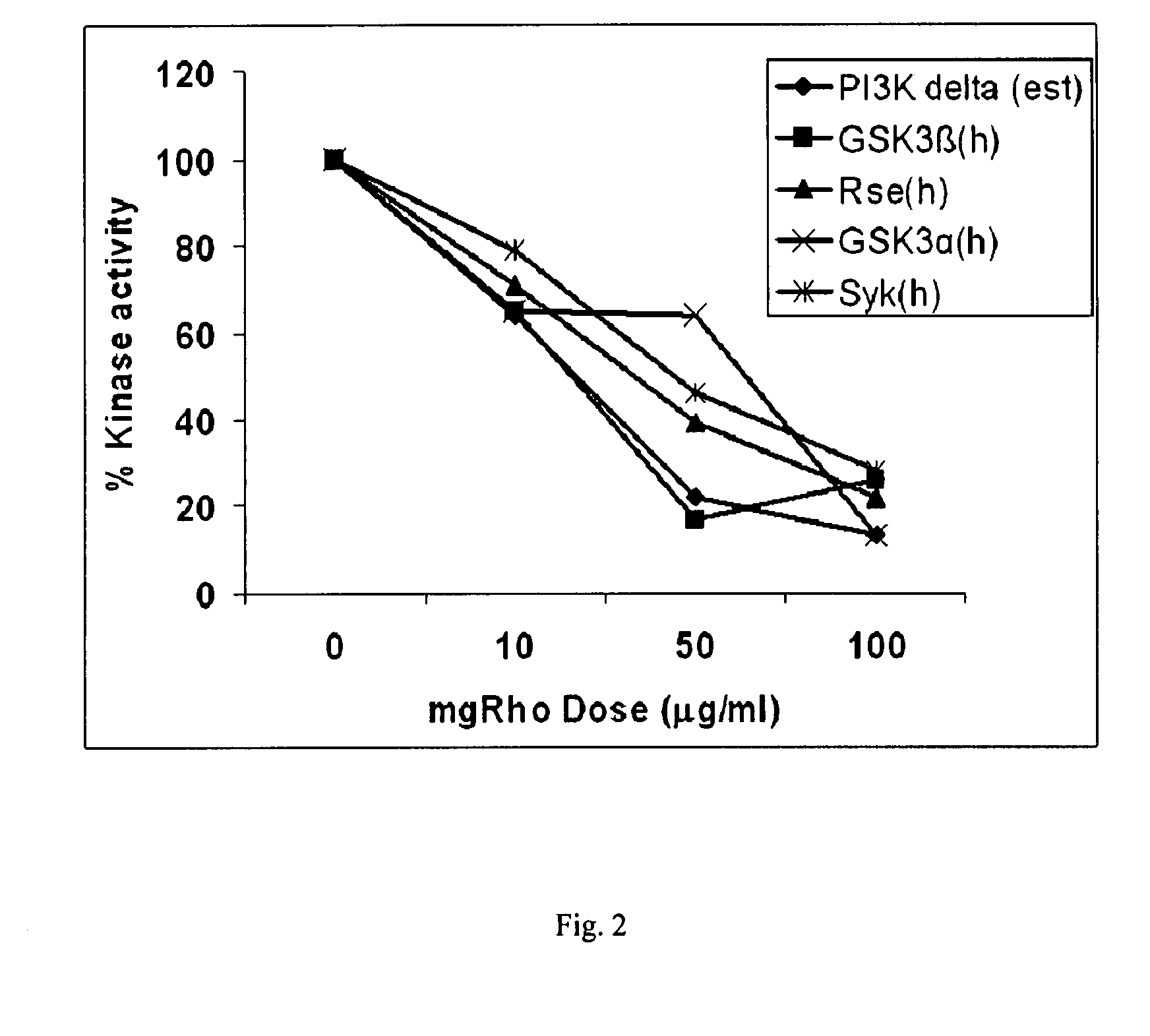Protein kinase modulation by hops and acacia products
a technology of protein kinase and hops, which is applied in the direction of drug composition, immunological disorders, metabolism disorders, etc., can solve the problems of inability to definitively cure, changes in the program of genes expressed in the responding cells, and treatment to reduce the severity of the disease, so as to inhibit the inflammatory response
- Summary
- Abstract
- Description
- Claims
- Application Information
AI Technical Summary
Problems solved by technology
Method used
Image
Examples
example 1
Effects of Modified Hops Components on Protein Kinases
[0164] As stated above, kinases represent transferase class enzymes that are able to transfer a phosphate group from a donor molecule (usually ATP) to an amino acid residue of a protein (usually threonine, serine or tyrosine). Kinases are used in signal transduction for the regulation of enzymes, i.e., they can inhibit or activate the activity of an enzyme, such as in cholesterol biosynthesis, amino acid transformations, or glycogen turnover. While most kinases are specialized to a single kind of amino acid residue, some kinases exhibit dual activity in that they can phosphorylate two different kinds of amino acids. As shown in FIG. 1, kinases function in signal transduction and translation.
[0165] Methods—The inhibitory effect of 10 μg RIAA / ml of the present invention on human kinase activity was tested on a panel of over 200 kinases in the KinaseProfiler™ Assay (Upstate Cell Signaling Solutions, Upstate USA, Inc., Charlottesvi...
example 2
Dose Response Effects of Hops or Acacia Components on Selected Protein Kinases
[0174] The dose responsiveness of mgRho was tested at approximately 10, 50, and 100 μg / ml on over sixty selected protein kinases according to the protocols of Example 1 are presented as Tables 2A & 2B below. The five kinases which were inhibited the most are displayed graphically as FIG. 2.
[0175] The dose responsiveness for kinase inhibition (reported as a percent of control) of a THIAA preparation was tested at approximately 1, 10, 25, and 50 ug / ml on 86 selected kinases as presented in Table 3 below. Similarly, an acacia preparation was tested at approximately 1, 5, and 25 ug / ml on over 230 selected protein kinases according to the protocols of Example 1 and are presented as Table 4 below. Preparations of isoalpha acids (IAA), heaxahydroisoalpha acids (HHIAA), beta acids, and xanthohumol were also tested at approximately 1, 10, 25, and 50 ug / ml on 86 selected kinases and the dose responsiveness results...
example 3
Effect of Hops Components on PI3K Activity
[0187] The inhibitory effect on human PI3K-β, PI3K-γ, and PI3K-δ of the hops components xanthohumol and the magnesium salts of beta acids, isoalpha acids (Mg-IAA), tetrahydro-isoalpha acids (Mg-THIAA), and hexahydro-isoalpha acids (Mg-HHIAA) were examined according to the procedures and protocols of Example 1. Additionally examined was an Acacia nilotica heartwood extract. All compounds were tested at 50 μg / ml. The results are presented graphically as FIG. 3.
[0188] It should be noted that all of the hops compounds tested showed >50% inhibition of PI3K activity with Mg-THIAA producing the greatest overall inhibition (>80% inhibition for all PI3K isoforms tested). Further note that both xanthohumol and Mg-beta acids were more inhibitory to PI3K-γ than to PI3K-β or PI3K-δ. Mg-IAA was approximately 3-fold more inhibitory to PI3K-β than to PI3K-γ or PI3K-δ. The Acacia nilotica heartwood extract appeared to stimulate PI3K-β or PI3K-δ activity. C...
PUM
 Login to View More
Login to View More Abstract
Description
Claims
Application Information
 Login to View More
Login to View More - R&D
- Intellectual Property
- Life Sciences
- Materials
- Tech Scout
- Unparalleled Data Quality
- Higher Quality Content
- 60% Fewer Hallucinations
Browse by: Latest US Patents, China's latest patents, Technical Efficacy Thesaurus, Application Domain, Technology Topic, Popular Technical Reports.
© 2025 PatSnap. All rights reserved.Legal|Privacy policy|Modern Slavery Act Transparency Statement|Sitemap|About US| Contact US: help@patsnap.com



